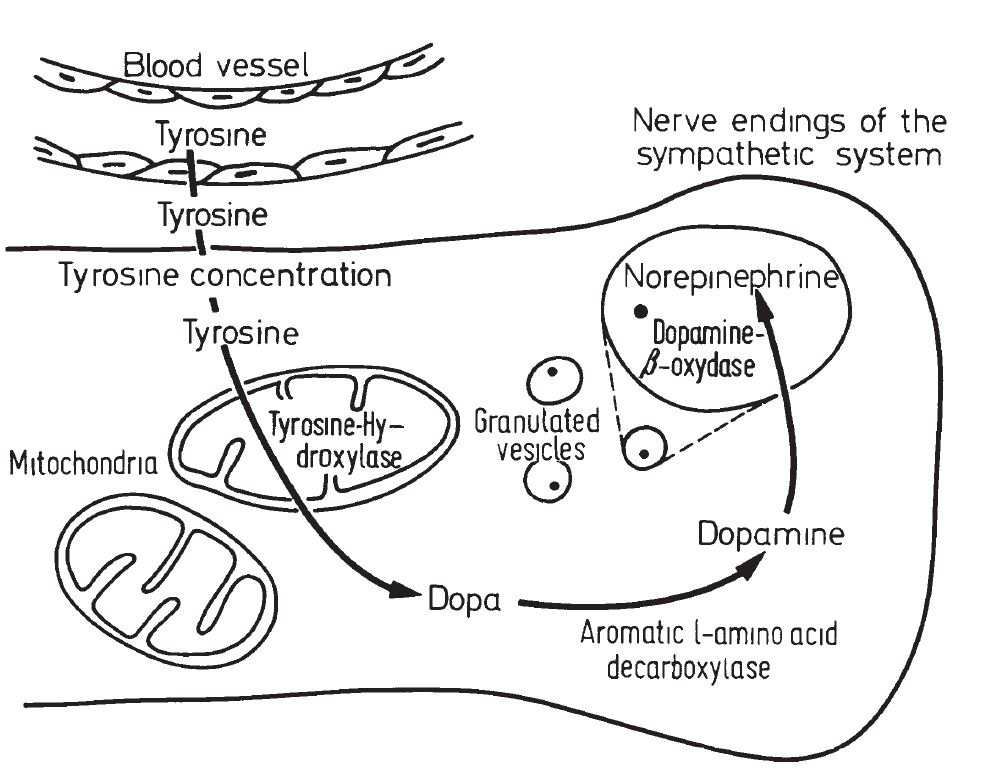The terms fractionated metanephrines and catecholamines will be defined. In addition, the diagnostic value of metanephrines and catecholamines in the evaluation of pheochromocytoma and paragangliomas (PPGLs) will be discussed.
Introduction
The adrenal medulla and cortex were first described as distinct zones of the adrenal gland by Cuvier around 1805. Oliver and Schafer discovered the existence of pressor-like substances from adrenal extracts in 1894. In an experiment by Schafer and Oliver, a glycerin-based extract of the suprarenal gland was injected directly into the vein of a dog after which they observed a dramatic increase in its blood pressure. The duo carried out a second experiment on a cat and observed a significant increase in blood pressure after injecting the same extract. They reported their findings in March 1894 at the Physiological Society in a lecture titled “The physiological action of the extract of the suprarenal capsules.”. The first catecholamine to be isolated and structurally characterized was adrenaline (epinephrine).
Definition of catecholamines
Catecholamines are a group of structurally related hormones that include epinephrine, norepinephrine, and dopamine. These hormones are produced primarily by the adrenal gland and play an essential role in the body’s stress response. Additional sites of catecholamine production include the brain, nerve endings of the sympathetic nervous system, retroperitoneal paraganglia, and chromaffin tissue (organ of Zuckerkandl). Epinephrine and norepinephrine possess a pyrocatechol ring as part of their basic structure, hence their name, catecholamines. Dopamine, an immediate precursor to epinephrine and norepinephrine, also possesses this pyrocatechol ring.
Definition of metanephrine
Metanephrines are metabolites of catecholamines (epinephrine, norepinephrine and dopamine) that are produced when catecholamines are broken down by specific enzymes in the body. Metanephrines are present in plasma or excreted in urine and can be measured to assess the extent of catecholamine activity in the body. Examples of metanephrines include: metanephrine, normetanephrine
Metabolism of metanephrines
Synthesis of metanephrines occurs in the chromaffin cells of the adrenal medulla. Catecholamines are synthesized from the amino acids phenylalanine and tyrosine in these cells. Phenylalanine is converted to tyrosine by the enzyme phenylalanine hydroxylase.
Tyrosine is then converted to L-dopa by the enzyme tyrosine hydroxylase. L-dopa is converted to dopamine by aromatic L-amino acid decarboxylase. Dopamine is further converted to norepinephrine by dopamine beta-hydroxylase. Norepinephrine is finally converted to epinephrine by phenylethanolamine N-methyltransferase. Phenylethanolamine N-methyltransferase requires cortisol as a cofactor in order to complete this critical conversion (methylation) of norepinephrine (noradrenaline) to epinephrine (adrenaline).
Catecholamines are stored within secretory granules present in the adrenal medulla. Conceptually, the adrenal medulla is a special type of neural synapse that conducts post-ganglionic nerve impulses to an end-organ via hormonal rather than a neural route. In essence, the adrenal medulla is a sympathetic nervous system ganglion with the ability to release secretory granules composed of catecholamines.

Metabolism of catecholamines
Catecholamines are destined for either their reabsorption into secretory granules of sympathetic nerve endings or through direct metabolism via O-methylation by the hepatic enzyme, catechol-O-methyltransferase (COMT). Metabolism of epinephrine and norepinephrine (catecholamines) by COMT, results in the formation of metanephrine and normetanephrine (referred to collectively as “metanephrines”)
These methylated metabolites (i.e., metanephrine and normetanephrine) may be excreted either completely unchanged in urine or partly metabolized into vanilylmandelic acid (VMA) by the enzyme monoamine oxidase (MAO).
| Urine metabolite | Distribution |
| Catecholamines | 3-7% |
| VMA | 40% |
| Metanephrines | 40% |
What are the functions of metanephrines?
Metanephrines have a variety of functions in the body, including regulation of blood pressure and heart rate, stimulation of the sympathetic nervous system, inhibition of insulin release, and bronchodilatory effects.
| Adrenergic receptor (location) | Tissue effects |
| α1 adrenergic receptor (smooth muscle of arteries and veins) | • Increases systemic blood pressure through vasoconstriction. • Positive inotropic effects |
| α2 adrenergic receptor (presynaptic surface of sympathetic ganglia and on smooth muscles) | Arterial vasodilation |
| β1 adrenergic receptors in cardiomyocytes | • Positive inotropic effects under direct stimulation by epinephrine and norepinephrine • Positive chronotropic effects through stimulation of the cardiac pacemaker cells • Receptors present in the juxtaglomerular cells of the kidney under stimulation by catecholamines release renin leading to activation of the renin-angiotensin-aldosterone axis |
| β2 adrenergic receptors (smooth muscles and sympathetic ganglia) | • Vasodilation of muscular arteries. • Induces increased norepinephrine release from sympathetic ganglia |
| D1 dopaminergic receptor (kidney vasculature) | Stimulation results in vasodilation of renal arteries |
| D2 dopaminergic receptor (presynaptic) | Negative inotropic effect by inhibiting norepinephrine secretion from sympathetic nerve terminals |
What are the medical applications of metanephrines?
Metanephrines are sometimes measured in urine or blood to assess catecholamine activity in the body. This can be useful in diagnosing conditions such as pheochromocytoma (a tumor of the adrenal gland).
What do high metanephrine levels mean?
The evaluation of metanephrine and normetanephrine in either urine or plasma (also known as fractionated metanephrines) is the preferred screening test for patients with suspected pheochromocytoma and paraganglioma syndromes. Plasma fractionated metanephrines are highly sensitive for diagnosing PPGLs due to the fact that these metabolites of epinephrine and norepinephrine are continuously produced by these tumors.
Conversely, catecholamines (epinephrine and norepinephrine) are produced intermittently by PPGLs; as such, their levels may be either normal or mildly elevated when these tumors are quiescent (in a resting state). This accounts for the lower sensitivity of catecholamines in the screening of PPGLs.
Elevations in catecholamines or metanephrines 2-3x the upper limit of normal is highly suggestive of a PPGL and warrants further testing.
Also, some medications will need to be discontinued at least two weeks before the test in order to reduce false positives. These include beta-blockers, nonselective alpha-blockers, acetaminophen, selective serotonin inhibitors, and tricyclic antidepressants.
Role of metanephrines in the diagnoses of pheochromocytomas
Catecholamines can be measured in blood or urine to assess catecholamine activity in the body. Metanephrines are metabolites of catecholamines that are produced when catecholamines are broken down by specific enzymes in the body. Metanephrines can also be measured in blood or urine to assess catecholamine activity in the body. The measurement of catecholamines and metanephrines can be useful in diagnosing pheochromocytoma.
The sampling of plasma fractionated metanephrines should be done after a patient has been in the fully recumbent position (supine) for at least 30mintes. Indeed, sampling patients in an upright standing or sitting position can increase these metabolites resulting in a 2.8 fold increase in the false positive rate.
| Tests | Sensitivity (%) | Specificity (%) |
| Plasma free metanephrine and normetanephrine | 96-100 | 85-89 |
| Plasma epinephrine and norepinephrine | 84 | 81 |
| 24 hr urinary metanephrine and normetanephrine | 98 | 98 |
| 24 hr urinary epinephrine and norepinephrine | 86 | 88 |
| 24 hr urinary VMA | 66 | 94 |
Dynamic Tests for confirming the diagnosis
Clonidine suppression test
The current gold standard confirmatory test for pheochromocytomas is the clonidine suppression test. This dynamic test is based on the pathophysiologic principle that clonidine, a central sympathoplegic agent, inhibits the release of norepinephrine by neurons in subjects who do not have a PPGL. However, for patients with a PPGL, this suppression is suboptimal, making sustained elevation of metanephrines after clonidine administration an important confirmatory test in this population.
To begin the test, the patient is made to lie supine for at least 20-30minutes. Baseline plasma metanephrines are then sampled. 300mcg of clonidine (for an average 75kg man) is then administered. Patients are then monitored periodically in order to detect unintended hemodynamic instability. After three hours, a second plasma metanephrine sample is drawn. A less than 40% reduction in plasma metanephrines is an abnormal test.
24hour urine collection
Instruct patients to refrain from the consumption of certain food products, such as bananas, citrus fruist, tea, coffee, vailla or nuts for at least two days prior to the collection of urine. Collected urine should also be protected from heat and direct sunlight. Also, medications that can interfere with optimal analysis should be avoided. These include salicylates, tetracyclines and sympathomimetic agents.
The role of catecholamines in the diagnosis PPGL
| Cause | Norepinephrine | Epinephrine | Dopamine |
| Sporadic pheochromocytoma | +++ | ++ | +- |
| MEN2 related pheochromocytoma | + | +++ | +- |
| VHL related pheochromocytoma | +++ | + | +- |
| Paraganglioma | +++ | - | +- |
| Malignant pheochromocytoma/paraganglioma | +++ | + | ++ |
Do functional paragangliomas secrete epinephrine?
The catecholamine synthesis pathway requires the cortisol-induced enzyme called phenylethanolamine N-methyltransferase (PNMT) in order to convert norepinephrine to epinephrine. Paragangliomas lie outside the adrenal gland as such, PNMT cannot be directly stimulated by cortisol, thus blunting the conversion of norepinephrine to epinephrine. In conclusion, all epinephrine-secreting tumors arise from the adrenal medulla, whereas all functioning paragangliomas produce only norepinephrine because of the lack of paracrine stimulation of PNMT by cortisol.
What is the definition of fractionated metanephrines?
This refers to the metabolites of epinephrine and norepinephrine (catecholamines), which are metanephrine and normetanephrine. Metanephrines represent an umbrella term for the metabolites metanephrine and normetanephrine
What is the definition of catecholamines?
This refers to epinephrine (adrenaline) and norepinephrine (noradrenaline).
References
- Grouzmann E, Tschopp O, Triponez F, et al (2015) Catecholamine Metabolism in Paraganglioma and Pheochromocytoma: Similar Tumors in Different Sites? PLOS ONE 10:e0125426
- Grouzmann E, Drouard-Troalen L, Baudin E, Plouin P-F, Muller B, Grand D, Buclin T (2010) Diagnostic accuracy of free and total metanephrines in plasma and fractionated metanephrines in urine of patients with pheochromocytoma. Eur J Endocrinol 162:951–960
- Kim HJ, Lee JI, Cho YY, et al (2015) Diagnostic accuracy of plasma free metanephrines in a seated position compared with 24-hour urinary metanephrines in the investigation of pheochromocytoma. Endocr J 62:243–250
Kindly Let Us Know If This Was helpful? Thank You!


